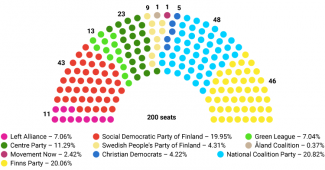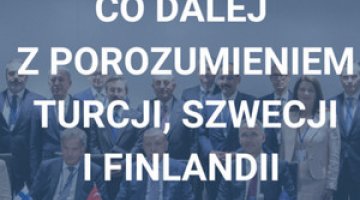Finland’s new government coalition: 2% of GDP to be allocated on defence despite budget cuts
On 20 June, Finland’s president Sauli Niinistö appointed a government composed of the centre-right National Coalition Party, the right-wing Finns Party, the centrist Swedish People’s Party of Finland and the Christian Democrats. A 240-page coalition agreement was published four days earlier. The cabinet has a slight parliamentary majority of 107 seats in the 200-seat parliament (Eduskunta). The formation of the coalition is the result of a process that lasted over two and a half months, starting from the parliamentary elections held on 2 April.
The new government will consist of 19 ministers: 8 from the National Coalition Party, 7 from the Finns Party, 2½ from the Swedish People’s Party of Finland and 1½ from the Christian Democrats (the latter two parties will control the ministry of culture for half a term each). Petteri Orpo, the leader of the National Coalition Party, will serve as Prime Minister; Riikka Purra, the leader of the Finns Party, has been put in charge of the Finance Ministry; Anna-Maja Henriksson, the chairperson of the Swedish People’s Party of Finland, has been put in charge of education; and Sari Essayah, the leader of the Christian Democrats, of agriculture. Antti Häkkänen and Elina Valtonen of the National Coalition Party were appointed as ministers of defence and foreign affairs respectively.
Commentary
- The coalition negotiations took seven weeks. The talks were turbulent and concerned almost every aspect of domestic and foreign policy. Considering how lengthy and detailed the negotiations were, the breadth of the coalition agreement, the disagreements between individual parties over many key issues and the coalition’s slim majority in parliament, the long-term stability of the Orpo cabinet is questionable. The Finns Party may be a destabilising factor, as it has a history of splitting the party and weakening the government due to its radical anti-immigrant views and inability to make political concessions (it was a member of the government coalition along with the Centre Party and the National Coalition Party in 2015–17; the parliamentary majority then shrank from 124 to 105 MPs).
- Reducing the budget deficit was the flagship proposal in the National Coalition Party’s campaign, and was thus the most important topic of the talks. The gap between revenues and expenditures in the annual budget is expected to decrease by €6 billion within four years. This goal will be achieved by cutting spending by €4.2 billion by 2027 while at the same time increasing revenues by €1.85 billion (Finland’s budget in 2023 is €83.5 billion, against a deficit of €10.4 billion). The largest cuts, amounting up to €2.5 billion, will affect the welfare system and healthcare, but they will affect practically all ministries. Defence spending will shrink by €50 million, but the government has also undertaken to maintain it at the level of at least 2% of GDP. In addition, the cabinet intends to increase investments in research & development to 4% of GDP by 2030. The funds for this are to come from additional restrictions on social spending and the sale of state assets. These measures will particularly affect the poorest citizens, who will lose a significant part of their benefits; this may adversely affect the Finns Party’s support ratings.
- In the new government’s opinion, “Russia’s foreign and security policy is irreconcilable with European stability and security”. Finland intends to force Moscow to end the war in Ukraine and counteract Russian aspirations to destabilise the European security system. The coalition is in favour of maintaining the current sanctions on Russia and imposing new ones, and will also work to further reduce Finland’s energy and economic dependence on Russia. It also plans to create a commission to study Russian influence in Finland in the 2000s. The construction of barriers along the border between the two countries will also continue. According to the coalition agreement, Helsinki’s policy towards Moscow may change in consultation with its partners from the EU and NATO, depending on how the domestic situation develops in Russia. The new government has also pledged to continue supporting Ukraine, including by supplying weapons to it. Helsinki is also in favour of developing international legal solutions that will allow frozen Russian assets to be confiscated and transferred to Kyiv. In the coalition agreement, the new cabinet declared its support for the ‘open door policy’ and Ukraine’s accession to NATO. It also supported Ukraine’s accession to the EU, but insisted that the country must meet all the necessary conditions.
- As regards NATO, the coalition has announced that it will continue the 360-degree approach, and that the country will be involved not only in collective defence operations but also crisis response and combating terrorism. Since nuclear weapons raise a great deal of controversy in Finland, the provisions concerning its participation in the Nuclear Planning Group should also be considered important. In NATO, Finland will focus on strengthening security in the Arctic and Baltic Sea regions, but also on security in the broader sense in cyber- and information space, combating hybrid threats and the use of artificial intelligence and quantum technologies in this area. It also intends to take steps to improve NATO’s situational awareness in space. The government has promised to make efforts to ensure a NATO presence in Finland in the form of a centre of excellence (rather than the deployment of an allied force). It has also reported plans to strengthen the European pillar in the Alliance. In addition, Finland will seek to develop bilateral military cooperation – in particular with the US, the UK, Sweden and Norway – through cooperation formats such as the bilateral Defence Cooperation Agreement (DCA) with the US which is currently under negotiation, the British Joint Expeditionary Force (JEF) and Nordic Defence Cooperation (NORDEFCO). A detailed report is to be prepared later this year, which will be used to develop detailed plans for the development of the Finnish Armed Forces and the country’s broader security policy, including Finland’s role in NATO.
- Finland also intends to continue strengthening both the Common Foreign and Security Policy (CFSP) and the EU’s trade policy. In the case of the CFSP, the Strategic Compass will be implemented to help achieve this goal. Although the government has declared its support for the common market for defence products, the provisions of the coalition agreement regarding developing EU initiatives on joint arms procurement (EDIRPA) and ammunition production (ASAP) are quite cautious. Finland does not want them to distort the domestic arms market or limit the country’s options for engaging in selected commercial projects by favouring the largest member states. The centre-right coalition has stressed that qualified majority voting (QMV) can only be allowed in certain areas of the CFSP, such as sanctions policy; it is also opposed to any treaty changes in this area, a reflection of the Finns Party’s Eurosceptic position. The previous government, the centre-left cabinet led by Prime Minister Sanna Marin, was more favourable towards German ideas and joined the QMV Friends Group created by Berlin at the beginning of May this year. Asylum and migration policy was an important issue which the Finns Party raised in the coalition negotiations. The cabinet has promised to curb immigration to the extent that EU law is respected. A new law is to be presented next year which will deprive unsuccessful asylum seekers of the possibility of applying for another form of legal residence. It will also allow them to be deported, even if they found work in Finland in the meantime.
Chart. The results of the parliamentary elections of 2 April and the distribution of seats in the Eduskunta

Source: Parliamentary Elections 2023, Ministry of Justice of Finland, tulospalvelu.vaalit.fi.





